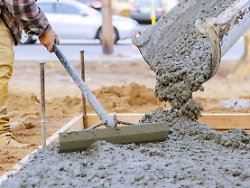Saturday 23 October 2021
More CO2 emissions than India
Concrete and cement fuel climate change
The need for concrete and cement is growing with increasing urbanization – especially in Africa and Asia. However, large amounts of CO2 are released during production, around one tonne of CO2 for every tonne of cement. That should change by 2050.
Cement and concrete are of enormous importance for construction and infrastructure projects around the world – but the effects on the greenhouse effect are just as huge: Cement production alone accounts for seven percent of global CO2 emissions, three times more than emissions from air traffic. “That is more than all the emissions of the entire European Union or India and is only behind those of China and the USA”, explains the climate researcher and co-chair of an expert group of the IPCC, Valérie Masson-Delmotte.
Concrete is the most widely used man-made product on earth. According to the London-based association of cement and concrete manufacturers GCCA, which represents the interests of the major players in the sector such as Holcim from Switzerland, Cemex from Mexico or CNBM from China, around 14 billion cubic meters of concrete are poured every year. And with increasing urbanization in many places – especially in Africa and Asia – the demand is likely to increase further in the future.
At the same time, large amounts of CO2 are released during manufacture. Cement is used as a binding agent to hold the aggregates such as sand and gravel together in the concrete. The cement, in turn, must first be sintered to cement clinker by heating clay and limestone and then ground. For the heating during sintering, temperatures of more than 1400 degrees Celsius are necessary in the furnaces. However, this also produces around one tonne of CO2 per tonne of cement.
“The cement industry wants to eliminate emissions by 2050”
The concrete industry itself wants to achieve “net zero” in greenhouse gas emissions by 2050. In October, the GCCA also announced that it would reduce CO2 emissions by 25 percent by 2030. A central point here are mechanisms for the separation and storage of CO2 (so-called carbon capture and storage). However, these technologies do not yet exist on a decisive scale.
Other options include recycling old material and replacing fossil fuels with renewable energy sources when firing the stoves. Industry heavyweights such as the Chinese state-owned company CNBM affirm that they want to play their part in decarbonising the industry.
However, decisive impulses could possibly come from a number of startups that are working on new methods: For example, Solidia from the USA wants to use CO2 to harden the concrete mix and thus minimize the amount of water required. In Canada, the company Carboncure is researching how liquefied CO2 can be stored in concrete.
Increased recycling could play a decisive role. According to the GCCA, 26 percent of cement clinker in Great Britain is based on recycled material. In France, where stricter sustainability requirements for the construction of new buildings will apply from next year, the young company Hoffman Green Cement is relying on extracting cement from industrial waste – from clay sludge, blast furnace slag and fly ash.
Despite the higher price for the cement, demand is high, says founder Julien Blanchard. “The cement industry wants to eliminate its emissions by 2050,” he says. You could start today, however. There is a lot at stake here: The United Nations estimates that three quarters of the world’s infrastructure by 2050 has yet to be built.
